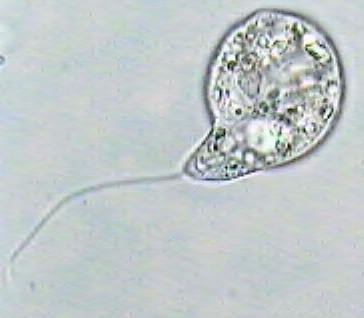 | ||
Two flagellates dancing
A flagellate is a cell or organism with one or more whip-like organelles called flagella. The word flagellate also describes a particular construction (or level of organization) characteristic of many protists (eukaryotic organisms) and their means of motion. The term presently does not imply any specific relationship or classification of the organisms that possess flagellae. However, the term "flagellate" is included in other terms (such as "dinoflagellate" and "choanoflagellata") which are more formally characterized.
Contents
- Two flagellates dancing
- Shiite muslims bleed as they flagellate themselves during muharram
- Form and behavior
- Flagellates as specialized cells or life cycle stages
- Flagellates as organisms the Flagellata
- References
Shiite muslims bleed as they flagellate themselves during muharram
Form and behavior
Eukaryotic flagella are supported by microtubules in a characteristic arrangement, with nine fused pairs surrounding two central singlets. These arise from a basal body. In some flagellates, flagella direct food into a cytostome or mouth, where food is ingested. Flagella often support hairs, called mastigonemes, or contain rods. Their ultrastructure plays an important role in classifying eukaryotes.
Among protoctists and microscopic animals, a flagellate is an organism with one or more whip-like organelles called flagella. Some cells in animals may be flagellate, for instance the spermatozoa of most phyla. Flowering plants do not produce flagellate cells, but ferns, mosses, Green algae, and some gymnosperms and closely related plants do so. Likewise, most fungi do not produce cells with flagellae, but the primitive fungal chytrids do. Many protists take the form of single-celled flagellates.
Flagella are generally used for propulsion. They may also be used to create a current that brings in food. In most such organisms, one or more flagella are located at or near the anterior of the cell, e.g., Euglena. Often there is one directed forwards and one trailing behind. Among animals, fungi, and Choanozoa, which make up a group called the opisthokonts, there is a single posterior flagellum. They are from the phylum Mastigophora. They can cause diseases and are typically heterotrophic. They reproduce by binary fission.They spend most of their existence moving or feeding. Many parasites that affect human health or economy are flagellates. Flagellates are the major consumers of primary and secondary production in aquatic ecosystems - consuming bacteria and other protists.
Flagellates as specialized cells or life cycle stages
An overview of the occurrence of flagellated cells in eukaryote groups, as specialized cells of multicellular organisms or as life cycle stages, is given below (see also the article flagellum):
Flagellates as organisms: the Flagellata
In older classifications, flagellated protozoa were grouped in Flagellata (= Mastigophora), sometimes divided in Phytoflagellata (= Phytomastigina) and Zooflagellata (= Zoomastigina). They were sometimes grouped with Sarcodina (ameboids) in Sarcomastigophora.
Presently, these groups are known to be highly polyphyletic. In modern classifications of the protists, the principal flagellated taxa are placed in the following eukaryote groups, which include also non-flagellated forms (A: autotrophic; F: free-living heterotrophic; P: parasitic; S: symbiotic):
Although the taxonomic group Flagellata was abandoned, the term "flagellate" is still used as the description of a level of organization and also as a ecological functional group. Another term used is "monadoid", from monad. as in Monas, and Cryptomonas and in the groups as listed above.
The amoeboflagellates (e.g., the rhizarian genus Cercomonas, some amoebozoan Archamoebae, some excavate Heterolobosea) have a peculiar type of flagellate/amoeboid organization, in which cells may present flagella and pseudopods, simultaneously or sequentially, while the helioflagellates (e.g., the cercozoan heliomonads/dimorphids, the stramenopile pedinellids and ciliophryids) have a flagellate/heliozoan organization.
